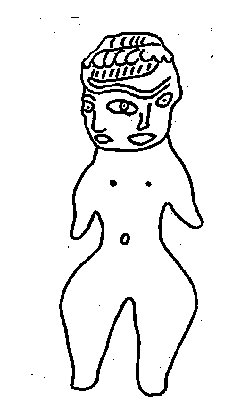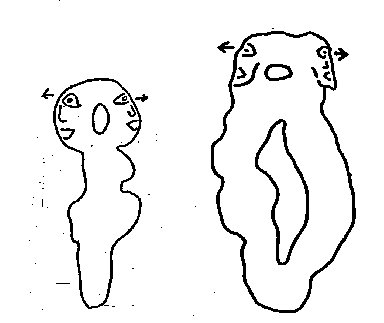In Mexico, in Tlatilco, a large number of ceramic female statuettes, which I consider "venuses", have been found. They have been dated from 1,100 to 500 BC (they are preserved in the National Museum of Anthropology in Mexico City).
These "venuses" are naked, without hands, without feet, all with a headgear or a hairstyle; they have the legs divaricate, and have not a basis to stay in vertical position. Most of these "venuses" have only one head, others are bicephalic, that is they are composed from a head with two faces (Fig 1)

Fig 1 Ceramic sculpture
and from two heads on an only body (Fig2).

Fig 2 Ceramic sculpture
I remind you that bicephalic figurines fall under bicephaly. These bicephalic "venuses" in Mexico are interpreted as "symbol of a double fruit or of the principle of duality, that represents one of the roots of the Mesoamerican religious philosophy, to which is attributed propitiatory character" . In my opinion "propitiatory character" had also the "venuses" with one only head, otherwise it is unclear for what reason they were made! It is thinkable, if not, that those two-faced ones have had a greater "propitiatory character".
Their size range from 6 to 13 cm in height, but the average is 10 cm. These figurines are the oldest in Central America, and some think they were produced in "a social state of female supremacy (matriarchy?)", and that they are " bearers of fertility of the species" .
These ceramic "venuses" can be considered as sculptures.
The amount of these ceramics suggests a cult rooted in the people, and therefore with roots very older of when have been made, and I have found these roots in the Paleolithic, in Italy, at the Balzi Rossi.
The great distances, in the Paleolithic, regarding the parallelisms on the evolution of art and religions, are made on the finds that are known, that have a geographic location; but the origin of these finds can be another zone of which we have no finds, and also at great distance, in how much the periods considered embrace millennia and, as we know, the man has always migrated in every direction.
The Balzi Rossi are constituted by a set of small caves and shelters under rock on the sea, they are in Liguria on the border with France. Man has left important traces here in the Paleolithic.
The sculptures that we examine have been found in these caves towards the end of the 800's by Louis Alexandre Jullien. Their cultural attribution is the upper Paleolithic, while the dating is between 28,000 and 22,000 years ago.
One of these sculptures (Fig 3)

Fig 3 and Fig 4 Greenyellow serpentine sculptures
depicts a "venus" with two heads, it has been called "The two-headed lady", 27.5 mm tall. It is devoid of feet and arms. On the right are the attributes of the female sex. It is pierced between the two heads, looking in opposite direction. (In the drawings Fig.3 and Fig.4 the features of the faces are indicative, in how much do not exist in the two sculptures).
The other sculpture (Fig.4) represents, united by the nape and by the feet, a "venus" and a " humanized animal", i.e. head of animal and human vertical body. It is tall 47 mm. The "venus" on the left has the attributes of the female sex. The two joined figures are without feet and arms, and have two perforations, one behind the nape of the neck, and another behind the back.
These two sculptures, differently from all the "venuses" found in Europe, are the only bicephalic, and have been found together with a small pierced "mask" of feline, 23 mm width.
These three small sculptures are in yellow greenish serpentine, not present in the zone. It is probable that these three small sculptures found at the Balzi Rossi come from "very far ", as the bicephaly in the European "venus" (and they are many) is not present; sculptures of "venus" pierced in the European Paleolithic are not present and, finally, the type of stone extraneous to the zone induces to doubt.
The characteristics of the two "venuses" and the feline mask have many traits in common with the wooden sculpture of equatorial Africa. Sure, who worked the wood, not worked the stone, but the man has always been able to make everything, in every direction. Independently from the doubts on the origin of the bicephalic sculptures (Fig.3 and Fig.4), it must be noticed that they join two different cults (real or presumed): 1°) the naked female is generally considered linked to the cult of the fecundity, and 2°) the two-faced, usually, is representation of a god.
The parallelism between the stone "venus" of Balzi Rossi, and the ceramic "venus" of Tlatilco must lead us to meditate about cultural evolution of peoples, and particularly about the complex religious net for which man produced art.
Copyright©2000-2002 by Paleolithic Art Magazine, all rights reserved.